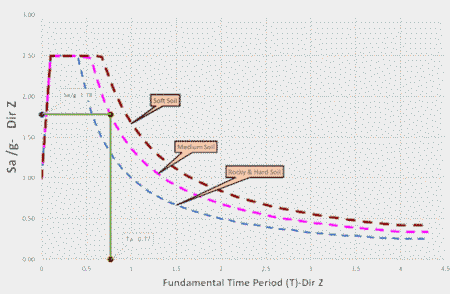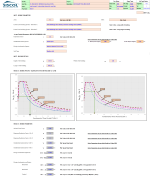IS 1893 SESIMIC CALC _ RS SPECTRA & EQUIVALENT STATIC

Description
Spreadsheet to calculate IS 1893: 2016 Seismic coefficient and base shear
Features included :
1. Option to include User defined time period as well as code specified based on empircal formula
2. Sa/g calculation updation based on both Equivalent static curve and response spectra curve
3. graphical reporesentation of Acceleration Vs time curve
4. Seismic coefficient calculated for both Orthogonal and Vertical direction
5. Base shear claculation based on user inputs includes features to include line load on beams as well as UDL and point Loads.
IS 1893: 2016 is the Indian Standard code for 'Criteria for Earthquake Resistant Design of Structures,' published by the Bureau of Indian Standards (BIS). It provides guidelines for designing structures to withstand seismic forces during earthquakes. One of the key aspects of the code is the determination of the seismic coefficient and base shear, which are used to estimate the lateral forces acting on a structure during an earthquake.
Seismic Coefficient:
The seismic coefficient is a dimensionless factor that accounts for the seismic hazard at a particular location, the importance of the structure, and its dynamic characteristics. It is used to convert the weight of the structure into an equivalent static lateral force, which represents the earthquake-induced forces. In IS 1893: 2016, the seismic coefficient is defined as the product of three factors:
-
Seismic Zone Factor (Z): Represents the level of seismic hazard in a specific region, based on historical earthquakes and geological conditions. India is divided into four seismic zones (Zone II, III, IV, and V), with Zone II having the lowest seismic hazard and Zone V having the highest.
-
Importance Factor (I): Represents the significance of the structure and its intended use. The importance factor varies from 1.0 to 1.5, with higher values assigned to structures that are essential for post-earthquake functionality or have a high occupancy.
-
Response Reduction Factor (R): Accounts for the energy-dissipating capacity and ductility of the structure. The response reduction factor is based on the type of lateral force resisting system used in the design, such as moment-resisting frames, shear walls, or braced frames.
The seismic coefficient (Ah) is calculated as:
Ah = (Z * I * Sa/g) / (2 * R)
Where:
- Sa is the spectral acceleration coefficient
- g is the acceleration due to gravity (approximately 9.81 m/s²)
Base Shear:
Base shear is the total horizontal force acting at the base of a structure due to earthquake-induced ground motion. It is calculated by multiplying the seismic coefficient by the total weight of the structure:
Vb = Ah * W
Where:
- Vb is the base shear
- Ah is the seismic coefficient
- W is the total weight of the structure
The base shear is then distributed vertically along the height of the structure according to a specific distribution pattern, such as the inverted triangular or the uniform pattern. The resulting forces are used to design the structural elements to resist the lateral forces induced by earthquakes.
IS 1893: 2016 provides detailed guidelines for calculating the seismic coefficient, base shear, and other design parameters required for designing earthquake-resistant structures. Engineers must follow these guidelines to ensure that structures can withstand seismic forces and minimize the risk of collapse or significant damage during an earthquake.
Calculation Preview
Full download access to any calculation is available to users with a paid or awarded subscription (XLC Pro).
Subscriptions are free to contributors to the site, alternatively they can be purchased.
Click here for information on subscriptions.




